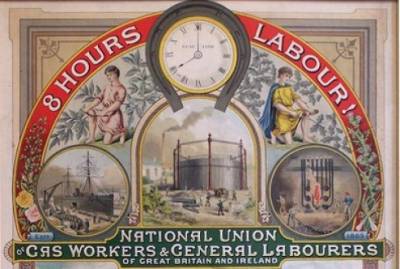Whole generations of people have lived, worked and died without leaving much of a trace behind. These working class people lived in the same towns and cities that we live in now, they walked on the same streets as us and occupied some of the same buildings, but their lives were different to ours in many ways.

A Smith
By understanding both what they did for a living, and how they banded together to get better conditions at work, we can get some sense of who they were. We can also make connections that might help us to understand our time and place a little better.
Many jobs from the past have disappeared completely from our modern world. In our collection we have details of trades such as:
Blacksmiths - toolmakers and metal workers who traditionally made horse shoes and tools, but worked in all types of industry including railways, engineering and shipyards.
Boilermakers - made boilers and were also general metal workers.
Brushmakers - made all types of brushes and brooms.
Gasworkers - produced gas that was used to light homes, streets and businesses.
Shipwrights - constructed the structure of a ship and most of the internal fittings.
Trade unions are groups of workers who have joined together to negotiate with their employers as a group rather than as a series of individuals.
From the 1799 and 1800 Combination Laws, which made it illegal for UK workers to band together to press for shorter hours or more pay, to the present day trade unions have battled to improve workers' rights and circumstances. They have also campaigned on wider issues such as gender, disability and racial equality.
The story of trade unions is at the heart of the Working Class Movement Library's collection.
Trade unions are all about organising people. Our collection reveals the nuts and bolts of how unions operated from the 1820s onwards: rule books, agendas, notices of meetings, minutes, agreements, campaigns, conference reports, leaflets, newsletters, badges and banners can all tell their own story. We also have biographies and histories and memoirs that trace this vital history.
A recent link between trade unions and the Library:
In May 2015 the General Secretary of the Trades Union Congress, Frances O'Grady, gave the sixth annual Frow Lecture. Her topic was 'The future of the left - where next for Labour, trade unions and the working class?'. The text of her speech can be downloaded here, and listened to here:
Related Objects of the Month
June 2014: The Woman Worker, September 1907, Volume 1 Number 1
 First published in 1906 by the National Federation of Working Women, The Woman Worker sought to further the work of the Federation through a combination of anecdotes, informative articles, allegories and relevant advertisements.
First published in 1906 by the National Federation of Working Women, The Woman Worker sought to further the work of the Federation through a combination of anecdotes, informative articles, allegories and relevant advertisements.
September 2010: First TUC meeting circular, September 1868
 The first Trades Union Congress was assembled by Manchester and Salford Trades Council and held at the Manchester Mechanics' Institute, Princess Street. This is a copy of the circular inviting unions to the Congress.
The first Trades Union Congress was assembled by Manchester and Salford Trades Council and held at the Manchester Mechanics' Institute, Princess Street. This is a copy of the circular inviting unions to the Congress.
August 2010: Police Strike ballot 1919
 In May 1919, the NUPPO issued a strike ballot calling for recognition of the union, re-instatement of PC Spackman and others and an increase in pay and pensions. The majority voted in favour of strike action, but the strike was postponed indefinitely.
In May 1919, the NUPPO issued a strike ballot calling for recognition of the union, re-instatement of PC Spackman and others and an increase in pay and pensions. The majority voted in favour of strike action, but the strike was postponed indefinitely.

